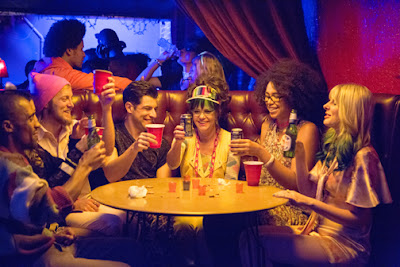Four stars. Rated PG-13, for dramatic candor, profanity, underage smoking and other questionable teen behavior
By Derrick Bang • Originally published in The Davis Enterprise, 4.29.16
I’m in love.
Much the way the young star of
this indie charmer worships the mysterious girl who lives across the street
from his school, I adore the filmmaking chops of Irish writer/director John
Carney.
He came to our attention Stateside
with 2007’s endearing Once, and its
music-laden saga of a Dublin busker and Czech immigrant who meet and then bond
over their shared love of songwriting and performing. Stars Glen Hansard and
Markéta Irglová fell in love during production, and it showed; nothing could
have been sweeter than their Academy Awards performance of the film’s signature
tune, “Falling Slowly,” which deservedly galloped home with an Oscar.
Carney detoured with a couple of
less successful projects before returning to the music world with 2013’s
equally appealing Begin Again, which
found washed up, Manhattan-based music exec Mark Ruffalo embracing one last
career shot by encouraging the efforts of fledgling singer/songwriter Keira
Knightley. As with Once, the action
unfolds against a backdrop of catchy, radio-ready new songs: another instant
soundtrack hit for delighted fans.
Pleasant as it was, though, a
certain something was missing from Begin
Again: something that has become obvious with the arrival of Sing Street. As a writer, Carney clearly
has the most fun exploring his Irish roots; this new film’s hard-scrabble,
working-class Dublin setting affords a rich tapestry of young angst and earthy
ensemble dynamics.
Carney sets his story in the
1980s, as a bleak employment depression sends ferryloads of young Irish
citizens to London, in the (often vain) hope of landing a steady paycheck.
Against this backdrop, 15-year-old Conor (Ferdia Walsh-Peelo) finds life at
home increasingly distressing. Parents Robert (Aidan Gillen) and Penny (Maria
Doyle Kennedy) are heading for a messy divorce, heedless of the impact the
process is having on Conor, his sister Ann (Kelly Thornton) and their older
brother Brendan (Jack Reynor).
Financial stress contributes to
the trauma, and one immediate change affects Conor personally. To save money,
he’s moved from his posh Jesuit private school to an inner-city comprehensive:
Synge Street School, laden with cigarette-smoking bullies barely kept under
control by mostly ineffectual priests. The one exception is the smugly
authoritarian Brother Baxter (Don Wycherley), a tyrannical monster who takes
pleasure in humiliating his students.
Barely into his first day, Conor
runs afoul of both Brother Baxter and the hulking Barry (Ian Kenny), a vicious
older student likely passed from one grade to the next, just so his previous
instructors can get rid of him.










